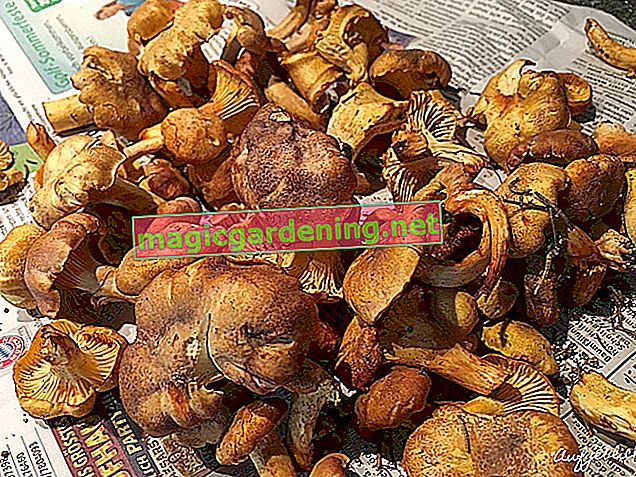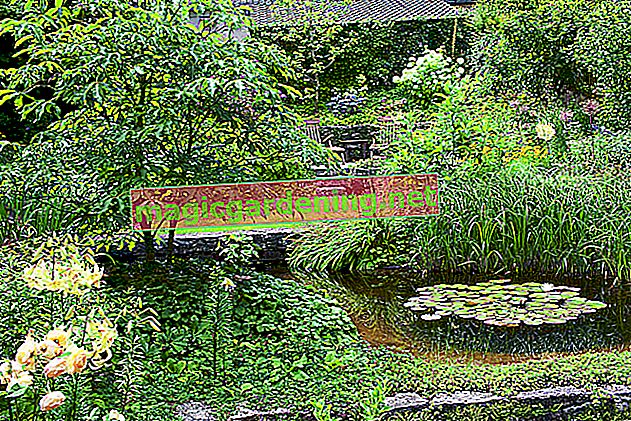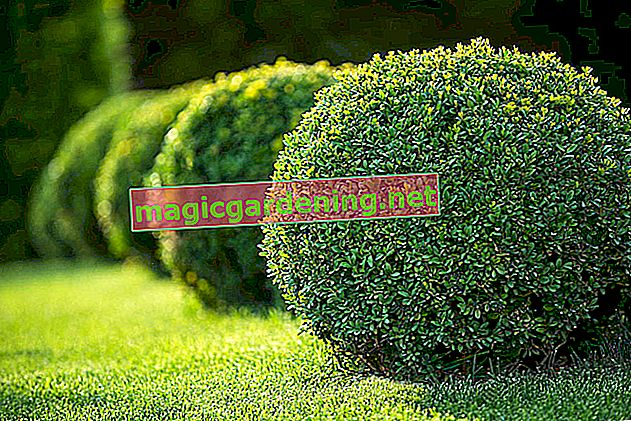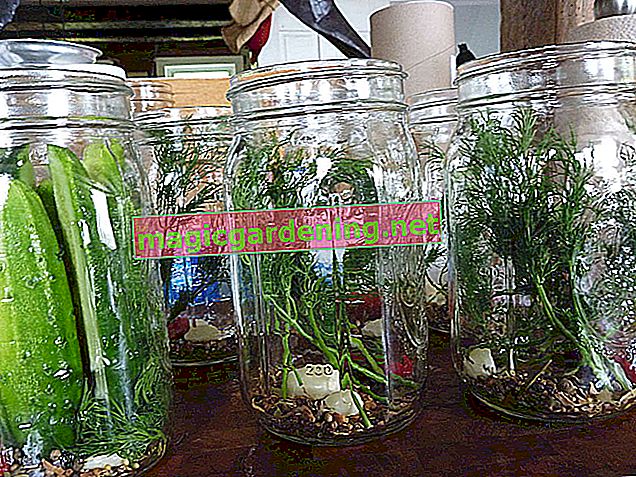
origin
Shame flowers represent the genus Aeschynanthus, which belongs to the Gesneria family. It comprises between 140 and 185 species, mainly found in southern and southeastern Asia and Oceania. Here the plants grow in the damp rainforests. Since botanists are constantly discovering new pubic flowers or classifying them into other genus, the number of species fluctuates. The species Aeschynanthus radicans and Aeschynanthus x splendidus are important in indoor culture.
also read
- Maintaining Aeschynanthus - tips and tricks
- Is the pubic flower poisonous or harmless?
- Increase the pubic flower - step-by-step instructions
growth
The herbaceous or shrubby plants wash persistently and are mostly evergreen. Within the genus there are two species that store water with their thickened plant parts. The shoots are mostly drooping and rarely upright or climbing. The stem axis can be branched or unbranched and grow up to 60 centimeters long. Shame flowers rarely grow rooting in the ground in their natural range. Most species are epiphytes that grow on other trees or on stones and rocks.
leaves
Pubic flowers develop opposite or whorled leaves that consist of a stem and a blade. The shape of the leaf blade differs depending on the species. There are narrow, egg-shaped or rounded leaves with a wedge-shaped, rounded or narrowed base. The leaves are soft or thick, hairy or glabrous. Aeschynanthus longicaulis develops marbled leaves with a green-white color.
blossom
The flowers of the pubic flowers stand individually or ten at the end of a stem axis. They are hermaphroditic and consist of five funnel-shaped fused petals. The corolla ends with two lips. The inside of the crown is slightly hairy or glabrous. The colored drawing inside the flower is typical of many species.
Heyday
The main flowering season extends from June to September, with Aeschynanthus species developing flowers from spring to the winter months under optimal conditions. Ornamental plants with a bright red corolla and a dark purple calyx are typical. Aeschynanthus speciosus flowers orange-red, with the interior of the flower colored orange-yellow.
fruit
After the flowering period, linear capsule fruits develop that protrude from the calyx. In some species the fruits can be up to 50 centimeters long. They contain between one and 50 seeds. Pubic flowers are pollinated by birds. Therefore, species and varieties cultivated as indoor plants only develop fruit through human intervention.
use
The ornamental flowers are used for interior greening. They are not suitable for outdoor cultivation. Shame flowers thrive in planters that decorate winter gardens and warm houses. Their habit makes them ideal plants for hanging plants.
Is Shame Flower Poisonous?
Since there are different statements about the toxicity of pubic flowers, you should cultivate the plant with caution in the nursery or on the cat balcony. While some sources present the plants as unproblematic, there are other indications of slight toxicity.
Continue reading
Which location is suitable?
The right location provides the plants with sufficient light. Shambumen do not tolerate direct sunlight. A place at the east or west window poses no problems for the plants. A few hours of sunshine in the morning or evening are not a problem.
humidity
Pubic flowers require high humidity. Place the planter in a planter, the bottom of which has been filled with pebbles. Pour some water into the planter. When it evaporates, it improves the microclimate. In addition, you should spray the plant with water every day.
How to provide an optimal microclimate:
- Cultivate pubic flower in a showcase
- alternatively place in a closed flower window
- grow in a mini greenhouse on the east or west window
What soil does the plant need?
Plant pubic flowers in a weakly acidic substrate with a pH between 5.0 and 6.0. You can use commercially available compost-based potting soil. With sand you improve the permeability of the substrate, because the plants prefer loose and coarse-grained soil. Mix in some clayey soil.
Increase the pubic flower
Aeschynanthus species are propagated via head and shoot cuttings, which can be cut all year round. Cut off ten centimeter long pieces of shoots and remove the bottom pair of leaves. In a mixture of peat and sand in equal parts, the cutting forms roots at a suitable location. This should be out of direct sun and ensure a temperature between 22 and 30 degrees Celsius.
Uniformly high air and soil moisture is the prerequisite for successful root formation. Fresh leaf shoots indicate that roots have developed. After one to two more weeks, the young plants can be pricked out or ten to 15 can be placed in a hanging basket (€ 14.99 on Amazon *).
Continue reading
Shame flower in the pot
Pots made from natural materials are great for growing pubic flowers. Clay, stone or terracotta have a porous structure that absorbs the irrigation water. In this way, the pots ensure a natural regulation of soil moisture. Excess water is removed from the substrate and directed outside. When it evaporates on the outside, the humidity increases automatically. The bucket should have several drainage holes so that no irrigation water collects on the bottom of the pot.
balcony
During the summer months, the pubic flower enjoys a place outdoors, provided that it is well shaded. The exotic plant cannot tolerate the harsh midday sun. Put the pot on the balcony when the night temperatures no longer drop below 15 degrees Celsius. A high level of humidity should also continue to be guaranteed.
In the greenhouse
The mini greenhouse for the window sill ensures a warm and humid microclimate and is therefore perfect for cultivating pubic flowers. Put a bowl on the floor that is always filled with water. The water evaporates through warm temperatures and ensures high humidity. Regular ventilation units should be the order of the day so that mold spores have no chance of settling.
Water the shame flower
From spring to autumn, pubic flowers have a moderate need for water. Make sure you water it evenly and sparingly so that the root ball does not dry out between waterings. When the pubic flower is in full bloom, you can increase the watering amount. From October to March, the substrate is kept drier, so that bud formation is stimulated.
Good to know:
- cold water harms the plants
- always use water at room temperature
- pour and sprinkle with soft or stale water
- filtered rainwater is optimal
Fertilize the pubic flower properly
During the growing season, you can fertilize the pubic flower every two weeks. Use a liquid complete fertilizer that you apply weakly concentrated over the irrigation water. When the plant is in the dormant phase, one or two fertilizers are sufficient.
Cut the pubic flower correctly
In early spring, before the growing season begins, the pubic flower can be pruned. Shorten shoots that have grown too long by two thirds. Non-woody shoots are cut off with a clean and sharp knife, while secateurs are suitable for woody shoot axes. If you don't prune the plant, it will grow increasingly expansive. Shame flowers get more beautiful over the years.
How do I transplant properly?
Pubic flowers should be repotted in early spring or in autumn after the flowering period. The plant reacts extremely sensitively to changed conditions. If you repot just before or during the flowering period, pubic flowers will suddenly shed their flowers.
As soon as the root ball takes up the entire pot or roots grow out of the drainage holes, the plants need a larger pot. Carefully tap the root ball on a surface so that all substrate residue loosens. Dead roots are removed. You can prune live roots to maintain a balance between leaf mass and root ball. This measure is recommended if you want to continue using the old pot. After repotting, protect the pubic flower from the sun for the next two to three weeks.
Overwinter
In a greenhouse with constant conditions all year round, pubic flowers do not take a rest. As the supply of light dwindles, growth slows noticeably. To stimulate flower formation, you should keep the plant at temperatures between twelve and 15 degrees Celsius and keep it as dry as possible.
Pests
Various pests occur on pubic flowers, which prefer to spread in winter and spring under suboptimal site conditions.
Aphids
Occasionally, pubic flowers are attacked by aphids in spring and early summer. They reproduce en masse within a very short time, because the females do not need a male sexual partner for reproduction. Weakened and over-fertilized plants are attacked more often.
Spider mites
If you can see fine cobwebs between the leaves, it indicates a spider mite infestation. They prefer to sit on the underside of the leaf and suck plant sap from the pathways near the leaf veins. At first you can see small spots on the leaves. If the infestation is severe, the leaves will die.
Thrips
They are among the rarer pests on pubic flowers that cause stunted growth and loss of leaves. The pests known as bladder feet multiply under dry and warm conditions that often prevail in winter quarters.
Tips
Get test strips from the pharmacy or gardening store that you can use to measure the pH of the soil. The value is essential for healthy growth.
sorts
- Aeschynanthus bracteatus: Climbing or hanging growth, leaves up to ten centimeters long. Flowers scarlet red in color, in clusters.
- Aeschynanthus longicaulis: Semi-creeping habit, leaves eight centimeters long, dark green. One to three flowers, orange-red. Shoots up to 90 centimeters long.
- Aeschynanthus marmoratus: Creeping perennial. Leaves glow green with dark marbling, underneath a reddish sheen. Flowers greenish-yellow with a brownish throat. Shoots up to 90 centimeters long.
- Aeschynanthus radicans: Initially aspiring, later overhanging shoots, woody. Leaves dark green, shiny. Flowers bright red with cream colored stripes in the center. Chalice black-red. .
 Sunflower seeds Peach Passion F1 2.49 EUR Buy from Pötschke
Sunflower seeds Peach Passion F1 2.49 EUR Buy from Pötschke








